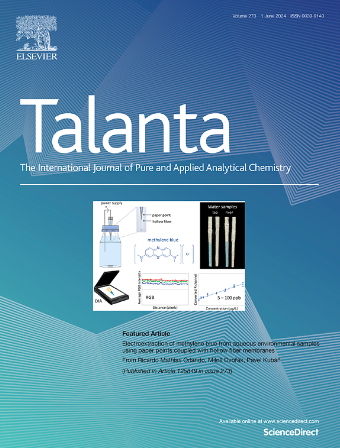一种 "关闭-开启 "荧光探针,用于对生物系统中的丙酮酸进行成像。
IF 5.6
1区 化学
Q1 CHEMISTRY, ANALYTICAL
引用次数: 0
摘要
丙酮酸(PA)是一种α-酮酸,具有重要的生物学和病理学功能。目前的 PA 分析方法主要基于紫外光谱和电化学生物传感器,需要杀死细胞和破坏组织,限制了其在活细胞中的应用。光学成像为更好地了解 PA 在生命系统中的生理和病理作用提供了无损的强大检测工具。然而,据我们所知,目前尚未开发出 "关-开 "PA 荧光传感器。在此,我们报道了一种 PA 识别反应,即芳基羟胺基团可被 PA 选择性地还原为乙酰酰胺基团。利用这一识别反应,我们设计、合成了一种基于光诱导电子转移(PET)途径的荧光探针(FPA),并能在 447 纳米波长处释放出强烈的荧光。我们证明了 FPA 可以检测水溶液、活细胞、草履虫和拟南芥根中的 PA,并具有良好的选择性和低至 0.42 μM 的灵敏度。此外,我们还成功地利用探针 FPA 研究了细胞内 PA 的产生途径,并评估了拟南芥根在不同生长阶段的生理水平。结果表明,拟南芥根中PA的生理水平与其生长阶段密切相关,这表明PA可能作为碳源和相关生长信号分子促进植物生长和根的伸长。因此,我们期待探针 FPA 成为更好地了解 PA 生理和病理作用的有力工具。本文章由计算机程序翻译,如有差异,请以英文原文为准。

An “off-on” fluorescent probe for imaging pyruvic acid in living systems
Pyruvic acid (PA) is an α-keto acid which exert important biological and pathological functions. The current PA profiling assays are mainly based on the ultraviolet spectroscopy and electrochemical biosensor, requiring killing cells and destroying tissues which limit their application in living cells. Optical imaging provides nondestructive powerful and detective tools to better understand the physiological and pathological role of PA in living systems. However, as far as we know, none of“off - on” PA fluorescent sensor has been developed. Herein, we reported a PA recognition reaction that arylhydroxylamine group could be selectively reduced to acetylamide group by PA. With this recognition reaction, a fluorescence probe (FPA) based on the photoinduced electron transfer (PET) pathway was designed, synthesized and could release strong fluorescence at 447 nm. We proved that FPA could detect PA in aqueous solution, living cells, Caenorhabditis elegans and the roots of Arabidopsis thaliana with good selectivity and sensitivity as low as 0.42 μM. In addition, we successfully using probe FPA to study the intracellular PA production pathway in cells and evaluated its physiological level in Arabidopsis roots at different growth stages. The results show that the physiological level of PA in Arabidopsis thaliana roots is closely associated with their growth stages, which indicated that PA might act as a carbon source and related growth signaling molecule to promote plant growth and root elongation. Therefore, we expect probe FPA to be a powerful tool to better understand the physiological and pathological role of PA.
求助全文
通过发布文献求助,成功后即可免费获取论文全文。
去求助
来源期刊

Talanta
化学-分析化学
CiteScore
12.30
自引率
4.90%
发文量
861
审稿时长
29 days
期刊介绍:
Talanta provides a forum for the publication of original research papers, short communications, and critical reviews in all branches of pure and applied analytical chemistry. Papers are evaluated based on established guidelines, including the fundamental nature of the study, scientific novelty, substantial improvement or advantage over existing technology or methods, and demonstrated analytical applicability. Original research papers on fundamental studies, and on novel sensor and instrumentation developments, are encouraged. Novel or improved applications in areas such as clinical and biological chemistry, environmental analysis, geochemistry, materials science and engineering, and analytical platforms for omics development are welcome.
Analytical performance of methods should be determined, including interference and matrix effects, and methods should be validated by comparison with a standard method, or analysis of a certified reference material. Simple spiking recoveries may not be sufficient. The developed method should especially comprise information on selectivity, sensitivity, detection limits, accuracy, and reliability. However, applying official validation or robustness studies to a routine method or technique does not necessarily constitute novelty. Proper statistical treatment of the data should be provided. Relevant literature should be cited, including related publications by the authors, and authors should discuss how their proposed methodology compares with previously reported methods.
 求助内容:
求助内容: 应助结果提醒方式:
应助结果提醒方式:


